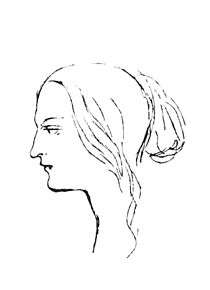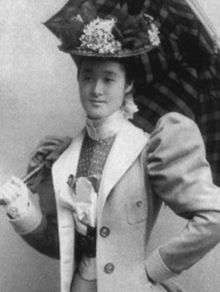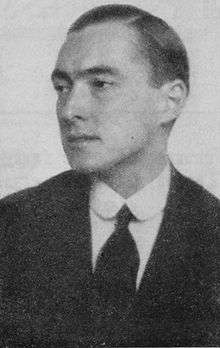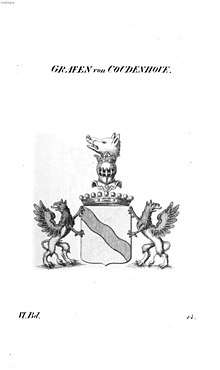Coudenhove-Kalergi family
The Coudenhove-Kalergi family is a noble Bohemian family of mixed European descent, which was formed after Count Franz Karl von Coudenhove (1825–1893) married Marie Kalergi (1840–1877). The Coudenhoves were Counts of the Holy Roman Empire since 1790 and were prominent in the Netherlands and Belgium. After the upheaval of the French Revolution, they went to Austria. The Kallergis family had enjoyed high status in Crete having been sent there by Byzantine emperor Alexios II Komnenos in the mid-12th century.[3] They remained there during the Venetian occupation 1204-1669 and subsequently moved to Venetian held Ionian Islands. Their palazzo in Venice is still there.
| Coudenhove-Kalergi | |
|---|---|
.jpg) The family's former castle in Ronsperg | |
| Parent house | Coudenhove (paternal line) Kallergis (maternal line) |
| Founded | 1903 |
| Founder | Heinrich von Coudenhove-Kalergi |
| Titles | Count of Coudenhove-Kalergi von Ronspergheim (awarded in 1918)[1][2] |



_by_Hans_Makart_(840-1884).jpg)


History
The Coudenhove family dates back to the Duchy of Brabant nobleman and crusader Gerolf I de Coudenhove (died 1259) and after it fought for the Habsburgs in the Dutch Revolt, the family moved to Flanders before the Habsburgs and Coudenhoves left after the Austrian Netherlands (Belgium) was taken by the Revolutionary French Republic.[4]
The Kallergis family is a Cretan family and claimed descent from the Byzantine Phokas family, which produced several generals and an emperor (Nikephoros II). During the Venetian rule over Crete, the Kallergis family was one of the most important Greek Orthodox families on the island.
The two families united when, on 27 June 1857 in Paris, Count Franz Karl von Coudenhove (1825–1893) married Marie Kalergi, only daughter of Polish pianist Maria Nesselrode and her husband, Jan Kalergis. The lands thus combined included the Zamato estate in the Carinthian mountains, the castle of Ottensheim in Upper Austria, and the Ronsperg (Czech: Poběžovice) estate and castle in western Bohemia.
Franz and Marie had six children, including Heinrich, the first count to use the double-barrelled name.[5] In 1917 when Heinrich's eldest son, Johannes Evangelist Virgilio Coudenhove-Kalergi, was 24 years old, he asked Emperor Charles I of Austria to give him the title Coudenhove-Kalergi of Ronspergheim (von Ronspergheim), and the Emperor granted this request.[1]
Family members
- Count Heinrich von Coudenhove-Kalergi (1859–1906), who married Mitsuko Aoyama and had:
- Johannes Evangelist Virgilio Coudenhove-Kalergi von Ronspergheim (1893–1965), author of the cannibalism novel Ich fraß die weiße Chinesin (I ate the white Chinese) by the pen name Duca di Centigloria.[2]
- Marie-Electa Thekla Elisabeth Christine Helene Sophie "Marina" Coudenhove-Kalergi von Ronspergheim (1927–2000), daughter of Johannes and his first wife Lilly. Married in Phoenix, Arizona in 1954. Died in Los Angeles in 2000.
- Count Richard Nikolaus von Coudenhove-Kalergi (1894–1972), Austrian writer, politician and founder of the International Paneuropean Union
- Gerolf Coudenhove-Kalergi / Count Gerolf von Coudenhove-Kalergi (1896–1978)
- Hans-Heinrich Richard Gerolf Karl Urban Maria Omnes Sancti Coudenhove-Kalergi (born 1926)
- Sophia Bowie Marie Coudenhove-Kalergi (born 1970)
- Dominik Cornelius Valentin Gerolf Eugene Coudenhove-Kalergi (born 1973), in 2009 he married Vincenz Liechtenstein's daughter Princess Adelheid Marie Beatrice Zita (born 1981).
- Xenia Marie Cornelia Hélène Zita Anna Therese Hildegard Omnes Sancti Coudenhove-Kalergi (born 2011)
- Tatiana Maria Mitsuko Benedikta Zita Sophie Ferdinandine Gisela Omnes Sancti Coudenhove-Kalergi (born 2013)
- Olympia Marie Gladys Zita Barbara Mauricette Elena Omnes Sancti Coudenhove-Kalergi (born 2016)
- Karl Jakob Maria Coudenhove-Kalergi (born 1928)
- Barbara Coudenhove-Kalergi (born 1932), Czech-Austrian journalist, Gerold's daughter
- Michael Coudenhove-Kalergi (born 1937), painter[2][6]
- Hans-Heinrich Richard Gerolf Karl Urban Maria Omnes Sancti Coudenhove-Kalergi (born 1926)
- Elisabeth Maria Anna Coudenhove-Kalergi (1898–1936), secretary of Engelbert Dollfuss
- Olga Marietta Henriette Maria Coudenhove-Kalergi (1900–1976)
- Ida Friederike Görres (1901–1971), sixth child of Heinrich von Coudenhove-Kalergi
- Karl Heinrich Franz Maria Coudenhove-Kalergi (1903–1987)
- Johannes Evangelist Virgilio Coudenhove-Kalergi von Ronspergheim (1893–1965), author of the cannibalism novel Ich fraß die weiße Chinesin (I ate the white Chinese) by the pen name Duca di Centigloria.[2]
Ancestors

Coudenhove family
- Franz Ludwig von Coudenhove (1783−1851), adjutant of Archduke Charles army[2]
- Maximilian von Coudenhove (1805−1889), Austrian feldmarschallleutnant
- Franz Karl von Coudenhove (1825–1893), father of Heinrich von Coudenhove-Kalergi (1859–1906)
- Max von Coudenhove / Max Julius Viktor Maria von Coudenhove (1865–1928), Austrian diplomat
Kalergis family
- Dimitrios Kallergis (1803–1867), foreign minister of Greece, minister of military affairs of Greece
- Maria Nesselrode (1822–1874), pianist and patronne having a relationship with many famous people: Heine, Balzac, Chateaubriand, Musset, Mérimée, Delacroix, Richard Wagner, Liszt, Chopin;[2] wife of Jan Kalergis
- Marie Kalergi (1840–1877), mother of Heinrich von Coudenhove-Kalergi (1859–1906)
References
- Kleisner, Tomas (2012). "The Medals of The Counts Coudenhove". Series C – Historia Litterarum vol.57. Academia.edu. p. 155. Retrieved 7 November 2014.
- "Familie Coudenhove". Paneuropa Deutschland - Paneuropa-Union. Archived from the original on 3 March 2016. Retrieved 7 November 2014.
- http://www.time.com/time/magazine/article/0,9171,791166-2,00.html
- Coudenhove t patricus.info
- "http://bischofteinitz.de/orte/ronsperg.htm Archived 2007-09-28 at the Wayback Machine
- "http://www.michael-coudenhove-kalergi.com/
External links
| Wikimedia Commons has media related to Coudenhove-Kalergi family. |